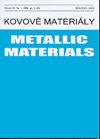Study of thermal properties of the aluminium EN AW 2024-T3 alloy
IF 0.7
4区 材料科学
Q4 MATERIALS SCIENCE, MULTIDISCIPLINARY
引用次数: 0
Abstract
The thermal properties of the aluminum EN AW-2024 alloy (duralumin) delivered in the T3 condition (solution annealed, quenched, cold-deformed, and naturally aged) were experimentally investigated using differential thermal analysis (DTA), differential scanning calorimetry (DSC), and light flash apparatus (LFA) for thermal diffusivity and thermal conductivity evaluation. The microstructure of the alloy in the initial state and after heating to 400 ◦ C was investigated by scanning electron microscope (SEM) and energy-dispersive spectroscopy. The presence of an exothermic thermal effect in the temperature range from 230 to 283 ◦ C during the first heating of the examined sample was determined by the results of DTA/DSC analysis. The thermal diffusivity of the investigated alloy was measured in the temperature range from 25 to 400 ◦ C using three heating runs. During the first heating, the thermal diffusivity of the investigated alloy increased with an increase in temperature up to approximately 300 ◦ C, after which it decreased. During the second and third heating, it was observed that the measured thermal diffusivity values at temperatures lower than 300 ◦ C were significantly higher than during the first heating, and the thermal diffusivity gradually decreased with increasing temperature in the entire investigated temperature range. Experimentally determined thermal diffusivity and density, as well as calculated specific heat capacity data, were used to determine the thermal conductivity of the studied alloy in the temperature interval from 25 to 400 ◦ C. The obtained results indicate that initial heating to a temperature above 300 ◦ C causes a significant increase in the values of the thermal diffusivity and thermal conductivity of the investigated 2024-T3 alloy.EN AW 2024-T3 铝合金的热性能研究
使用差热分析(DTA)、差示扫描量热仪(DSC)和用于评估热阻系数和导热系数的光闪仪(LFA),实验研究了在 T3 条件(固溶退火、淬火、冷变形和自然老化)下交付的铝 EN AW-2024 合金(硬铝)的热性能。利用扫描电子显微镜(SEM)和能量色散光谱仪研究了合金初始状态和加热至 400 ◦ C 后的微观结构。根据 DTA/DSC 分析的结果,确定了受检样品首次加热时在 230 至 283 ◦ C 的温度范围内存在放热热效应。通过三次加热,在 25 至 400 ◦ C 的温度范围内测量了所研究合金的热二重性。在第一次加热过程中,研究合金的热导率随着温度的升高而升高,最高温度约为 300 ◦ C,随后下降。在第二次和第三次加热过程中,观察到温度低于 300 ◦ C 时测得的热阻值明显高于第一次加热时的热阻值,而且在整个研究温度范围内,热阻值随着温度的升高而逐渐降低。实验测定的热导率和密度以及计算得出的规格热容数据被用于确定所研究合金在 25 至 400 ◦ C 温度范围内的热导率。
本文章由计算机程序翻译,如有差异,请以英文原文为准。
求助全文
约1分钟内获得全文
求助全文
来源期刊

Kovove Materialy-Metallic Materials
MATERIALS SCIENCE, MULTIDISCIPLINARY-METALLURGY & METALLURGICAL ENGINEERING
CiteScore
1.20
自引率
14.30%
发文量
36
审稿时长
3 months
期刊介绍:
Kovove Materialy - Metallic Materials is dedicated to publishing original theoretical and experimental papers concerned with structural, nanostructured, and functional metallic and selected non-metallic materials. Emphasis is placed on those aspects of the science of materials that address:
the relationship between the microstructure of materials and their properties, including mechanical, electrical, magnetic and chemical properties;
the relationship between the microstructure of materials and the thermodynamics, kinetics and mechanisms of processes;
the synthesis and processing of materials, with emphasis on microstructural mechanisms and control;
advances in the characterization of the microstructure and properties of materials with experiments and models which help in understanding the properties of materials.
 求助内容:
求助内容: 应助结果提醒方式:
应助结果提醒方式:


